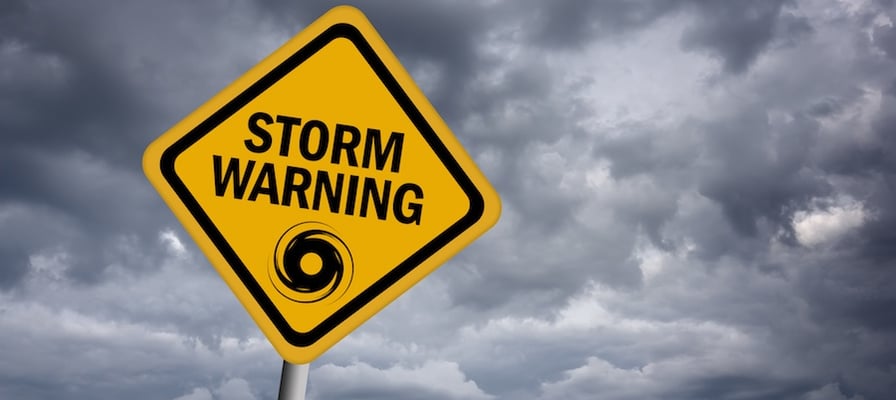
Hurricanes the size of 2017's Harvey and Irma are disruptive to nearly every aspect of human civilization, but supply chain and transportation industries are particularly vulnerable businesses.
They are uniquely impacted on several different levels––where most industries are simply trying to open their doors again, they lean on transportation in the process.
As a key tool for disaster recovery, drivers, shippers, and other transportation-linked positions aren't allowed the same space to assess and recover; they need to ramp up efficiency and output to better serve those in need.
In some cases, such as the transport of medicine or potable water, continuing to operate is a literal matter of life or death for affected areas.
Unprecedented Trendlines
For an at-a-glance idea of just how much this hurricane-steeped season has already affected the industry, look no further than DAT's recent trendline report. With flatbed-load-to-truck ratios up more than 7% from the last week of September to the first week of October, the difference is easier to see in year-over-year reports––the same category is up a startling 226% over 2016's numbers.
For an industry already busy trying to staunch the bleeding of an increasingly worrisome driver shortage, this volume of demand is difficult.
The transportation industry faces incredible pressure to perform, not just at capacity but beyond it when we have a supply chain affected by hurricanes.
The problem with this scenario is that they are, at the same time, just as prone to the disruptions and damages facing property owners or less vital businesses.
There are a number of challenges facing a transportation provider during hurricane logistics:
- Trucks themselves may be damaged by storm winds or even storm surges on coasts.
- Drivers may be at risk attempting to navigate during low-visibility or high-hazard weather conditions.
- Drivers and warehouse staff may need to travel to loved ones or evacuate themselves.
- Warehouses can become damaged or inaccessible due to storm damage.
- Routes, roads, tunnels, and bridges may become damaged or inaccessible due to storm damage.
- Loads can become damaged or compromised by weather, depending on storage locations.
- Understaffed warehouses and trucking teams may be vulnerable to looting or theft during crisis periods.
Transportation companies must balance efforts at resuming their normal workflow schedules, meeting humanitarian responsibilities, and protecting their own people and assets during weather events––which is hardly an easy task.
The Impact on Your Transportation Teams
Responding efficiently to a disaster demands unprecedented teamwork. As a client of a transportation provider, you are uniquely positioned to lend a hand and help iron out the ripple effect a disaster has on logistics providers.
In doing so, you aren't just helping individuals at risk during the storm; you're also reducing the time it will take your provider to get back to business as usual––meaning your own shipments.
It's a win-win situation in the middle of what would otherwise be a very damaging crisis.
Here's how you can help:
Understand Limitations:
One of the easiest ways to help is to simply be understanding about the situation. It's stressful when you can't receive your items or services when you expected to, of course, and you likely have some of your customers clamoring for delivery.
However, you should hopefully be able to trust your logistics provider is working as hard and fast as they can. They're likely dealing with increased overall capacity––your competitors will place orders when their provider(s) fall through––and route planning headaches complicating your usual transportation channels.
Processing these additional variables takes time and manpower, which might temporarily delay deliveries. If possible, don't commit to tight or unrealistic date-specific deliveries down your supply chain; leaving a little wait-and-see cushion will keep disappointment and frustration at bay as recovery progresses.
Offer Space:
If your warehouse has extra space that isn't being used for day-to-day operations, reaching out to freight brokerage teams to offer cross-docking functionality, even temporarily, can make a huge difference.
As the saying goes, a rising tide lifts all boats. When your freight brokerage team can reduce their backlog, they can get to your needs more quickly, as well.
Prioritize the Ethical:
A trustworthy logistics provider won't artificially increase their rates to take advantage of storm-distressed clients. Hopefully, yours does not. While some added costs may be unavoidable, follow suit and don't capitalize on shortages in your own business. This will make a bad situation even worse.
This also extends to "clearing out" products, services, or truckloads for the sake of "staying on top" during a disaster: recognize that it's often considerably more ethical to scale back for a neighbor to have access, as well.
Commit to serving your industry and community with integrity, no matter how harshly extreme weather events disrupt the flow of freight. Again, reducing variables during a time when supply chain-linked businesses are short on capital, capacity, and manpower will keep everything running more smoothly until normalcy can be restored.
To Sum It Up
Hurricanes, like an industry-wide flat tire, tend to slow the transportation industry down and make course-correction a challenge.
By staying aware of capacity concerns and remaining realistic about performance, you can be part of the recovery effort and gain a strong logistics ally in the process.
As each unfortunate ice storm, flood, hurricane, or wildfire occurs, we can learn how to adapt and plan for future unavoidable events.
Teamwork, smart planning, and realistic responses are the key to surviving any natural disaster, and that's doubly true when it comes to your transportation provider. The next time the Doppler radar threatens your operational area with a swirl of dangerous-looking color, face the storm with a balance of determination and a safety first mindset: your provider will thank you for it.
Lastly, as your overall freight costs rise with the rest of the industry in its current state, proactively search for ways to lower your expenses and maximize your efficiency. Our eBook offers an in-depth look at a few key strategies to get you started:



